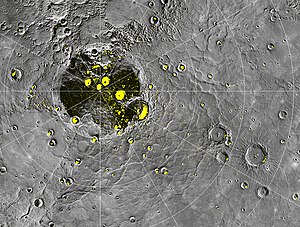Tolkien (crater)
 MESSENGER image with Tolkien at center. The north pole is on the rim of Tryggvadóttir, the crater at left foreground. | |
| Planet | Mercury |
|---|---|
| Coordinates | 88°49′N 211°05′W / 88.82°N 211.08°W |
| Quadrangle | Borealis |
| Diameter | 50 km |
| Eponym | J. R. R. Tolkien |

Tolkien is one of the northernmost craters on Mercury, located in the Borealis quadrangle (north pole region) at 88.82 N, 211.08 W.[1] It is 50 km in diameter. It was named after the South African born British writer J. R. R. Tolkien. The name was approved by IAU's Working Group for Planetary System Nomenclature on August 6, 2012.[1] Since Tolkien is very close to the north pole, and Mercury has almost no axial tilt, Tolkien receives very little sunlight.[2] S band radar data from the Arecibo Observatory collected between 1999 and 2005 indicates a radar-bright area covers the entire floor of Tolkien, which is probably indicative of a water ice deposit.[3][4][5][6]

See also[edit]
References[edit]
- ^ a b "Tolkien (crater)". Gazetteer of Planetary Nomenclature. USGS Astrogeology Research Program., accessed 19 February 2019
- ^ "Permanently Shaded Polar Craters". NASA/Johns Hopkins University Applied Physics Laboratory/Carnegie Institution of Washington/National Astronomy and Ionosphere Center, Arecibo Observatory. 15 November 2012.
- ^ Chabot, N. L., D. J. Lawrence, G. A. Neumann, W. C. Feldman, and D. A. Paige, 2018. Mercury's Polar Deposits. In Mercury: The View After MESSENGER edited by Sean C. Solomon, Larry R. Nittler, and Brian J. Anderson. Cambridge Planetary Science. Chapter 13, Figure 13.2.
- ^ NASA/Johns Hopkins University Applied Physics Laboratory/Carnegie Institution of Washington (16 March 2015). "Hot and Cold".
- ^ PIA19411: Water Ice on Mercury, NASA/Johns Hopkins University Applied Physics Laboratory/Carnegie Institution of Washington
- ^ John K. Harmon, Martin A. Slade, Melissa S. Rice, 2011. Radar imagery of Mercury’s putative polar ice: 1999–2005 Arecibo results. Icarus, 211, p37-50. doi.org/10.1016/j.icarus.2010.08.007
External links[edit]
 Media related to Tolkien (crater) at Wikimedia Commons
Media related to Tolkien (crater) at Wikimedia Commons
